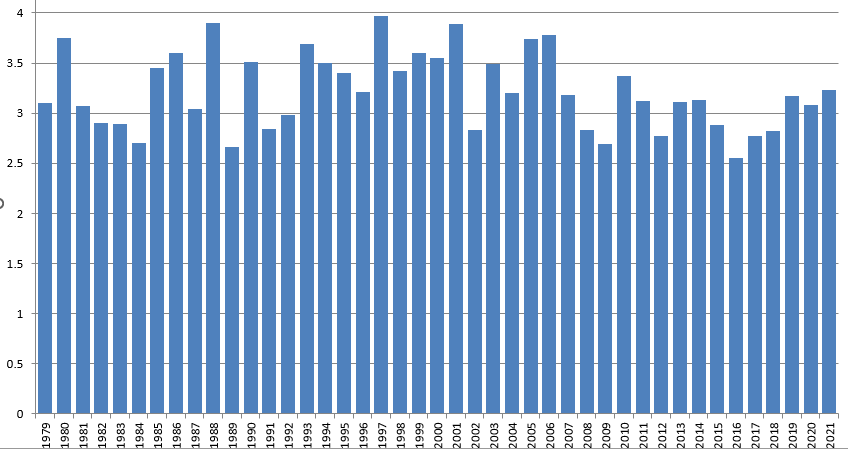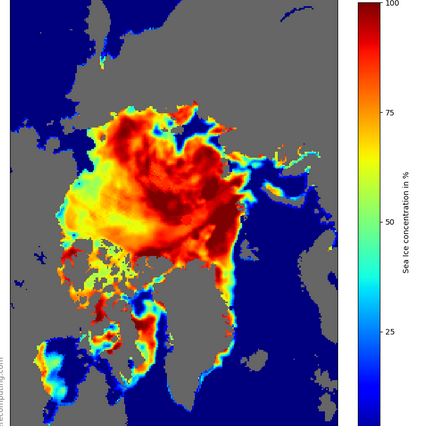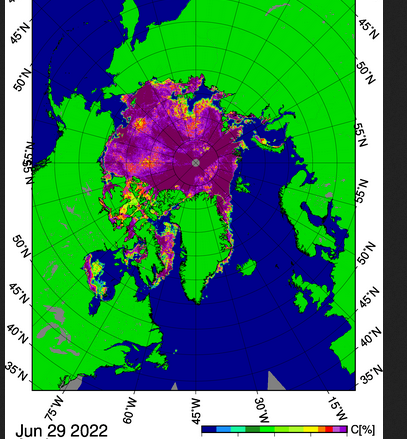-
Posts
90,902 -
Joined
-
Last visited
Content Type
Profiles
Blogs
Forums
American Weather
Media Demo
Store
Gallery
Everything posted by ORH_wxman
-
Where are you getting the area numbers from? There hasn’t been a minimum above 4 million sqkm since 2006.
-
Bluewave’s numbers were extent while I’m posting area. Area is a little different.
-
Update: As of 7/12, NSIDC area was 6.26 million sq km. The cold cyclone over the CAB right now continues to slow the area loss. Here are where other years compared on the same date: 2021: -730k 2020: -750k 2019: -930k 2018: -190k 2017: -70k 2016: -620k 2015: -210k 2014: +30k 2013: -120k 2012: -940k 2011: -460k 2010: -330k 2009: +230k 2008: +40k 2007: -490k
-
Update: Now having data 10 days into July, we’ve seen 2022’s melt slow even further relative to the post-2007 field. On 7/10, NSIDC area stood at 6.35 million sq km. Here are where other years stood compared to 2022 on the same date: 2021: -480k 2020: -620k 2019: -820k 2018: -190k 2017: -20k 2016: -540k 2015: -90k 2014: +200k 2013: +20k 2012: -680k 2011: -280k 2010: -270k 2009: +230k 2008: +130k 2007: -350k Theres currently a deep, cold low pressure over most of the CAB right now and that is not forecasted to move much over the next 5-6 days….so I’m skeptical we play much catch-up in the next week. There are signs that it may try and drift more to the ESS/Chukchi beyond that time frame, so perhaps the melt will pick up again if that happens. But we’re wasting what’s left of the prime sun angle up there in the meantime.
-
Update: On 7/1, the NSIDC SIA sootd at 7.07 million sq km. Here's how other years compared on the same date: 2021: -70k 2020: -510k 2019: -450k 2018: +320k 2017: +10k 2016: -240k 2015: +130k 2014: +260k 2013: +340k 2012: -650k 2011: -210k 2010: -380k 2009:+640k 2008: +220k 2007: -400k For the minimum Sea ICe Area prediction, we can use prior years' melt out from July 1st onward to estimate how this tear will turn out because there hasn't been much of a trend in ice loss after 7/1....the big trend has been prior to 7/1. We have maybe seen a slight increase in melt from 7/1 since 2007, so I will weight those years more. Below is a table of how 2022 would turn out if it followed previous years' melt out from 7/1 onward.... For example, if we used 1989's ice loss from here on out, we'd finish at 2.66 million sq km. 2016 had the highest meltout beyond 7/1 on record, and would produce a final SIA min of 2.55 million sq km if we followed that path in 2022. You'll note that the record year of 2012 is only like 4th or 5th most ice loss from 7/1 onward which means most of the damage was done prior to 7/1. We can pretty much rule out a new record this season based on this data. We'd need to obliterate the post 7/1 loss record set in 2016 to achieve it. A top 3 lowest min is probably out too.....likewise, a top 3 highest min in the post-2007 context is likely out as well....though another 2010 from here on out would achieve it. All other post-2007 years would fail, however. All that said, the average ice loss from 7/1 onward in the post-2007 era is 4.09 million sq km which would produce a 2022 min of 2.98 million sq km (7.07 million minus 4.09 million). I'm going to stick very close to this number and go with a final minimum of 3 million sq km +/- 300k. I might hedge a little higher if the forecast was colder on the Beaufort/CAA side over the next week but they will continue to see mild weather so I will stick with 3 million. Final extent prediction is a lot harder than area because extent relies a lot upon compaction/dispersion which is really hard to forecast. But that said, usually something in the 3 million sq km range for area will produce an extent min on NSIDC of around 4.5-4.8 million sq km. So I will go with 4.6 million +/- 500k....I have larger error bars on the extent. (side note: JAXA extent usually comes in around 200k lower than NSIDC extent after their algorithm update post-2013....so I will not be using Jaxa to verify this prediction. Only NSIDC daily extent)
-
Yeah the melt-ponding has been very extensive over the Beaufort/Chukchi/CAA portion of the ice....see below. The first image is the NSIDC (SSMI/S source) one and the second is AMSR2. Note how the concentration is much higher on the AMSR2 image because it's not fooled by melt-ponding nearly as much like SSMI/S is.
-
Update: The accelerated melt ponding from the dipole has pushed 2022 more toward the higher melt years of the pack now instead of being near the high-retention years....but still not into the highest tier level like 2012. NSIDC SIA on 6/29/22 stood at 7.12 million sq km. Below are how other years compared on the same date: 2021: +40k 2020: -50k 2019: -280k 2018: +490k 2017: +310k 2016: +20k 2015: +410k 2014: +400k 2013: +560k 2012: -510k 2011: -30k 2010: -310k 2009: +910k 2008: +550k 2007: -180k I'm away the next few days but I'll have my final prediction for SIA minimum when I get back and the 6/30 and 7/1 data is in. Unless there are drastic changes over the next couple days, this year's prediction is probably going to be somewhere between a top 5 and top 10 melt year....I don't think it has quite enough juice to make a top 3 and the dipole recently has done enough damage to take a result like 2009/2013/2014/2018 out of the equation.
-
Update: The melt has picked up a bit with the dipole pattern currently in progress across the arctic basin. As of 6/22, the NSIDC SIA stood at 8.09 million sq km. Here's how other years compared on the same date: 2021: -520k 2020: -430k 2019: -390k 2018: +350k 2017: +20k 2016: -480k 2015: +30k 2014: +70k 2013: +270k 2012: -650k 2011: -140k 2010: -480k 2009: +710k 2008: +50k 2007: -460k The dipole pattern looks like it will persist for another 4 days or so and then the low currently in the ESS will migrate toward the Beaufort/CAB and produce a reverse dipole which would slow the sfc melt down again. So the time to rack up losses is right now and the next few days.
-
When I first started looking more into NSIDC SIA as a predictor around 10 years ago, I almost chose 6/20 as the cutoff date because it's not that much less accurate than 6/30....so I think most of this season is likely baked into the pie at this point. There have a been a few years (like the previously mentioned 2008) which really went crazy the final 10 days of the month to end up closer to the bigger melt seasons, but a large majority of the seasons were pretty baked by the solstice. I think the best-guess theory (with the assistance of some literature on melt ponding) is that there simply isn't enough time in the melt season to make up for a lack of melt-ponding in the first 3 weeks of June. If you fall behind in the melt-ponding during that period, you pretty much cannot catch back up unless you really have some crazy anomalous weather. Most of the melting in the 2nd half of the summer is from bottom melt rather than surface melt (sfc temps cool back below freezing pretty quickly late summer), so you need as much surface melt momentum as possible early on to achieve a big melt season...and lots of melt-ponding helps enhance sfc melt by lowering albedo and increasing heat transfer, etc.
-
Update: NSIDC SIA stood at 8.39 million sq km as of 6/20/2022. Here's where other years stand now: 2021: -580k 2020: -720k 2019 -470k 2018 +90k 2017: -50k 2016: -420k 2015: -170k 2014: -80k 2013: +60k 2012: -740k 2011: -330k 2010: -450k 2009: +710k 2008: +70k 2007: -610k You can see there's some pretty clear divergence now between the huge melt years and the higher retention years. There's still some time for movement (2008 lost a lot in the final 10 days of June), but 2022 is quickly trending toward years like 2018/2017/2014/2013. There is a dipole pattern setting up over the next week or so....if 2022 is going to make a move toward the big dog melt years, it has to be during this next week.
-
Update.... NSIDC SIA stood at 8.65 million sq km as of 6/16 How other years compared to 2022 on this date: 2021: -320k 2020: -410k 2019: -520k 2018: +50k 2017: +120k 2016: -330k 2015: -70k 2014: +150k 2013: +110k 2012: -800k 2011: -330k 2010: -190k 2009: +670k 2008: +180k 2007: -170k
-
Update (NSIDC SIA stands at 8.72 milion sq km as of 6/15): 2021: -90k 2020: -220k 2019: -460k 2018: +140k 2017: +110k 2016: -280k 2015: -50k 2014: +80k 2013: +190k 2012: -730k 2011: -200k 2010: -210k 2009: +660k 2008: +210k 2007: -140k 2022 is starting to fall behind the pace of loss on the top melt years like 2012, 2016, 2020, 2011, 2007, etc. Gonna need it to pick up quite a bit over the next 2 weeks to have a shot at a new record or even top 3. I think there's probably too much ice in the Beaufort/Canadian Basin/CAA this year for a huge season.
-
Almost time to start tracking the sea ice area daily....I usually wait until after 6/15 to do that as we're still a bit early. For a refresher for those who don't follow this every year, the NSIDC sea ice area at the end of June is able to predict final minimum extent and area quite skillfully because the NSIDC algorithm is relying on SSMI/S satellite data which gets fooled by melt ponding into thinking there is open water....something that the other satellites aren't susceptible to. The reason that is important is melt ponding is an excellent predictor of sea ice extent/area minimum. If we had perfectly accurate measurements of melt ponding publicly available, we wouldn't have to use NSIDC area, but for now, NSIDC is a good proxy. Here's where other years stand in relation to 2022 NSIDC area as of today: 2021: -210k 2020: +160k 2019: -100k 2018: +110k 2017: +10k 2016: -500k 2015: +90k 2014: +220k You can see there is a mishmash of results there that doesn't tell us much yet. 2022 has more ice than last year at this time but less than 2020 which was a huge melt year. However, the real separation starts occurring once we get toward 6/20 and beyond. Years like 2020 went absolutely nuclear over the next couple weeks. I'll prob update these again in about a week and then do more frequent updates as we get into the final 10 days of the month.
-
I like the marginal snow sounding over the interior on the NAM for early Sunday morning. Prob at least some pingers in there with that super cold layer near 900.
-
Nice mother's day weekend disaster on the Euro....awful. Hopefully trends back south...or at least trends north to give us good rain. But that solution is the worst. dogshit temps and mist but not a ton of precip outside of SW CT.
-
Trends are def good. When you get defined east-based Nina, December comes in big fairly frequently (see 2017, 2007, 2005, 1995, 1970)...keeping it weak is better though for later in winter as noted by the '95 and '17 analogs....'05 didn't really follow that mold though you could say Feb '06 was a bit unlucky and we should've scored more than that one coastal.
-
Hopefully the Euro is more correct with the cutoff staying well south...so we'd at least be far enough north to get a decent amount of sun and avoid the horrific onshore flow. GFS on the other hand basically makes it a full-on mother's day weekend massacre.
-
Agreed. Wind was way down today which felt amazing.
-
Snowfall in last hour/Snow depth change since last 6 hour obs/ Snow depth
-
Look at the peak of the heavy snow....mid afternoon.....they prob wouldve gotten 20"+ if it was 6 hours later.
-
-
Just had a shower come through.....dropped temp back below 50 briefly. Best spring week of the year continues. We'll see if we can pull a freeze tonight to add to the summer preview.
-
Bump....this was actually pretty well-forecasted by model guidance.
-
Got up to 55F earlier this morning but it has since dropped to 51F and clouded over and wind has been picking up. Awesome weather for 4/27....best spring ever continues.
-
Early summer cancelled again on the Euro this run. In line to bend us over for mother's day weekend. Hopefully it goes back to the 00z look.










